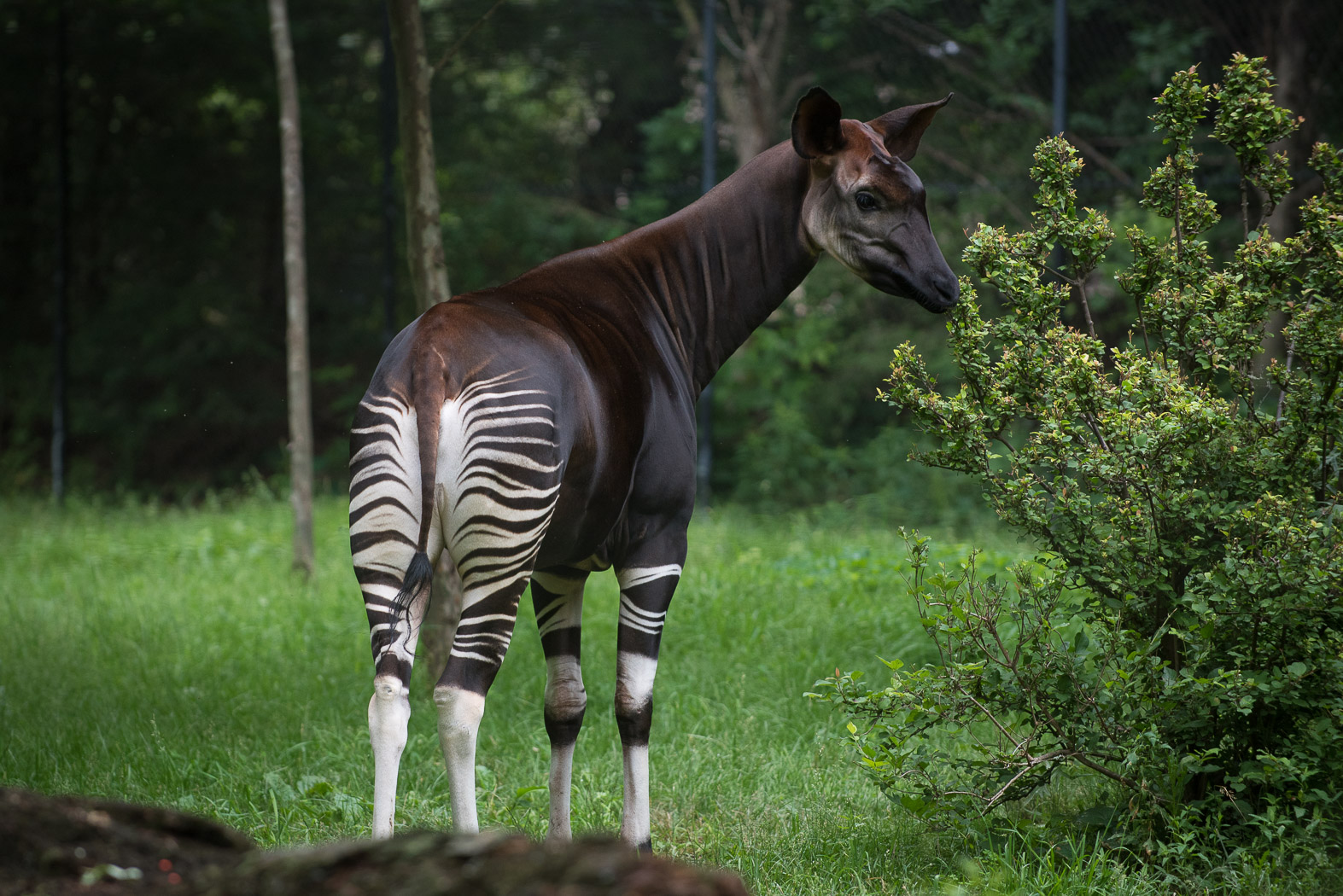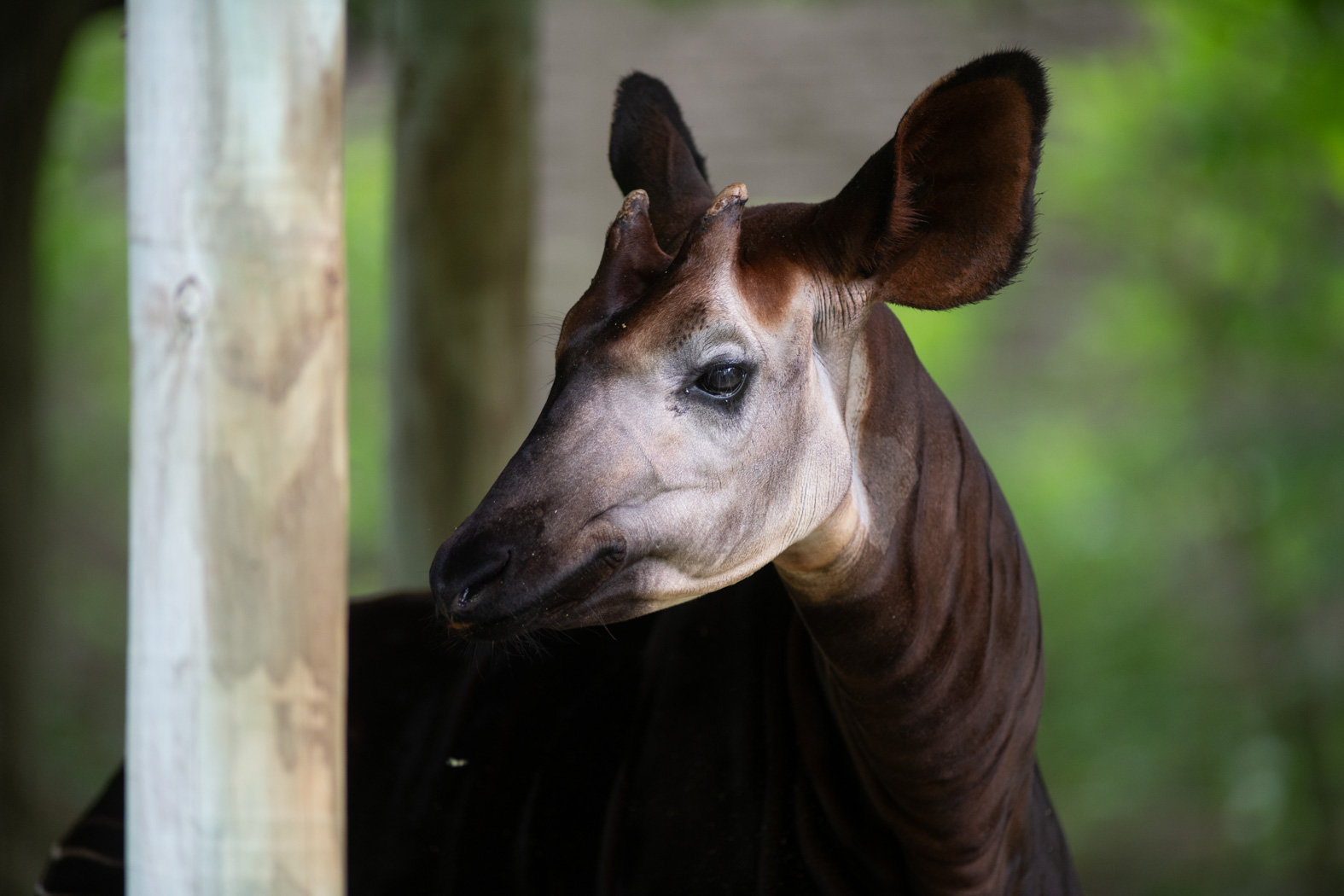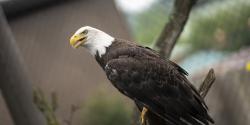
When you stroll by the okapi habitat at the Columbus Zoo and Aquarium, you may be curious!
This mysterious-looking animal inspires a sense of mystery for Columbus Zoo visitors. In fact, okapi are so elusive that they were not known to the western world until the 20th century.
About Okapi
Although it looks reminiscent of the zebra, the okapi is most closely-related to the giraffe. In fact, the okapi is the only living relative of the giraffe! Like a giraffe, okapi have large eyes and large flexible ears, cloved hooves, and males have short, bony structures called ossicones on their heads. Okapi also have a very long, prehensile tongue which can be up to 18in long and, like a giraffe’s, is used to help strip the buds and leaves from trees in the understory of its rainforest home.
They have a short but dense coat that feels like velvet to the touch. It’s also oily, so water glides off, making them perfectly adapted to the wet conditions in the rainforest. The okapi’s unique coat pattern serves as camouflage. The stripes across the okapi’s hindquarters and legs mimic the streaks of sunlight coming down through the trees, helping the okapi disappear into the forest.
Habitat and Diet
Okapis are mammals that are only found in the dense Ituri rainforest of northeastern Democratic Republic of the Congo. They inhabit the canopy rainforests at elevations of 1476 - 4900 feet and are very difficult to find among the dense vegetation. They’re also shy animals and use highly-developed hearing and eyesight to elude predators as well as human interaction. Their secretive nature and dense forest home make the okapi very difficult to observe.
Okapi will often travel up half a mile a day in search of food. They are browsers, eating up to 60 pounds of vegetation a day, mostly comprised of leaves but with some fruits, seeds, ferns, and fungi, too.
Family Life
Okapis are mostly solitary animals, only coming together to breed. A male’s range averages about 5 square miles. Males are territorial and will mark their territories to discourage other males from passing through. How? A scent gland on each foot leaves a sticky, tar-like substance where they walk.
These shy animals are famous for their ability to move through the forest almost silently. Okapi have limited communication because of small vocal cords, so they communicate through coughs, bleats, and whistles, but they can still produce sounds at very low frequencies. These calls are so low that they can only be heard by humans through specialized computer programs.
Okapis are pregnant for around 440 days and babies, called calves, are born weighing up to 60 pounds. Young okapi are often kept hidden in the forest by their mothers to avoid detection from predators.
Okapi Fun Facts
- Thanks to their long, prehensile tongues, the okapi is the only animal that can lick their own ears.
- Okapi are also known as forest giraffes, Congo giraffes, or zebra giraffes
- The main predator of the okapi is the leopard
- Okapi emit low frequency sounds beyond the range of human hearing. Only computer analyses can reveal these infrasonic communications.
- There were no images of an okapi in the wild until 2008, when the first pictures were captured on a camera trap.
Okapi at the Columbus Zoo

The Columbus Zoo and Aquarium is home to four adult okapi, the youngest of which is Matoke. Born at the Columbus Zoo on April 12, 2012, he lived with his mother, Miliki, until 2014 when he was transferred to the San Diego Zoo Safari Park. There, he grew to be a fully mature male weighing 560 pounds, and, in 2022, he returned to the Columbus Zoo where he currently resides in the Congo Expedition region. Matoke splits his time each day between a large outdoor habitat yard where he can roam and our large temperature-controlled barn where he spends his nights. He’s loved by the keeper staff for his sweet personality and loves to receive neck and ear scratches from his favorite keepers.
He also has a big appetite! Matoke eats 12 pounds of hay and six pounds of grain every day. His favorite food is fresh lettuces, often fed to him through environmental enrichment devices like balls and specialized feeders. These devices provide mental stimulation as well as an opportunity to use his long, prehensile tongue to get his food.
Conservation
Okapi are classified as endangered by the International Union for Conservation of Nature (IUCN). Although their native environment makes it difficult to get firm assessment data, the remaining population appears to be in steep decline over the last few decades. It is estimated that there may be more than 35,000 okapis in their native ranges, but no one knows for certain. The species continues to be threatened by habitat loss due to logging and illegal mining.
- The Okapi Conservation Project was established in 1987 to protect okapi populations.
- The Okapi Wildlife Reserve, a World Heritage site that covers approximately 20% of the Ituri Rainforest, has been made a protected site.
With the help of the Columbus Zoo and other zoos and conservation organizations, and the local community, efforts are being made to protect and support the study of this rare and unusual forest dweller. By supporting the Columbus Zoo and Aquarium and our connected conservation organizations, you are an ally in saving and protecting wildlife.









